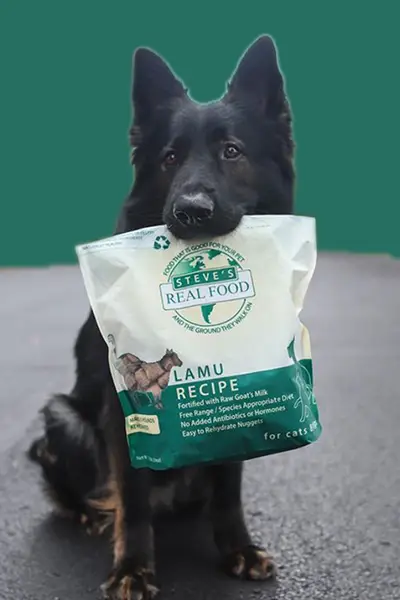Cats & Dogs; How Similar Are They, Really?
A quick overview of their physical appearance shows us similarities between cats and dogs; ears that rotate to pick up sound undetectable by humans, long, sharp teeth designed for ripping and tearing meat, and body structures built to catch live prey. All of these are physical markers of a carnivore. Unfortunately, it’s not that simple.
Dog Nutritional Requirements
Though both species hunt and prefer a fresh kill, how successful they are at hunting has affected their evolution. Dogs are actually known as opportunistic hunters, meaning they’ll scavenge or eat fresh berries and flowers when they are unable to catch fresh prey, which happens often. The plant foods they consume contain carbohydrates, and over time the dog’s pancreas evolved to produce the digestive enzyme amylase which helps break down the carbohydrates into energy. Because of this, some claim that the dog is actually an omnivore and unfortunately, many kibble makers have latched onto this idea.
Even though dogs are equipped to utilize some carbs, the amount is very important. On average a dog can readily digest between 4-14% carbohydrates in their diet, but most kibble on the market today contains between 46-75% carbohydrates. It’s very taxing on a dog’s body to continually process such a high carb load day in and day out and it can actually lead to many ailments, such as obesity because eventually, those extra carbs start getting stored as fat.
Cat Nutritional Requirements
Cats, on the other hand, are obligate carnivores meaning their food and energy requirements are derived solely from animal tissue. They need a diet high in meat, especially because cats are extremely successful at hunting and therefore never developed the need to scavenge like their counterparts. In turn, their pancreas hasn’t developed the ability to produce enough amylase to convert carbohydrates into energy. Instead, carbs are stored as fat, which is why feline obesity is so common in our house cats.
The high meat diet of the cat is absolutely crucial in providing necessary amino acids, fats, and pre-formed vitamins.
Let’s take a look:
- Arginine– A building block for protein, this amino acid is critical for an animal’s internal chemical factory functioning
- Dogs: produce enzymes internally that aid in the production of arginine
- Cats: are sensitive to even one meal without arginine. Cats require a lot of protein and arginine aids in the elimination of protein waste products
- Niacin-An essential B Vitamin that must be obtained through diet
- Dogs: can convert the amino acid Tryptophan into Niacin or obtain it by eating it already pre-formed
- Cats: cannot convert Tryptophan into Niacin and must obtain it already pre-formed in their diet
- Taurine– An amino acid that is found throughout most body tissues, necessary for healthy functioning of the heart, retina, reproduction, and bile function
- Dogs: can make their own taurine
- Cats: cannot make their own taurine, it must come from a diet high in meat protein
- Vitamin A– Also called Retinol is required at a cellular level for both cats and dogs
- Dogs: have an enzyme in the lining of their intestine that can convert plant carotenoids into active Vitamin A
- Cats: must obtain theirs pre-formed through a prey animal
Nutritional requirements are just one of many differences between cats and dogs, and we’ve only scratched the surface here. One important takeaway is that both species are classified as carnivores. The amount of meat in their diet plays an important role in their health. Equally important is that their diet be low in carbohydrate content which is exactly what we did at Steve’s Real Food. Our entire original lineup consists of a high meat/low carb ratio and is an ideal diet for the canine. We actually boosted this lineup with extra taurine to satisfy the nutritional needs of cats as well, but we didn’t stop there; our Quest cat food line goes one step further in replicating a feline’s prey, appropriately coined a “prey-model” diet consisting of 95% meat/organ/bone is the optimal diet choice for a feline. Whichever you’re feeding, you can do so with confidence!
 Beef
Beef Chicken
Chicken Whitefish
Whitefish Pork
Pork Lamb
Lamb Turkey
Turkey Turducken
Turducken All Protein
All Protein Beef
Beef Chicken
Chicken Whitefish
Whitefish Pork
Pork Lamb
Lamb Turkey
Turkey Duck
Duck All Products
All Products Frozen Raw Pet Food
Frozen Raw Pet Food
 Freeze Dried Raw Pet Food
Freeze Dried Raw Pet Food
 Frozen Prey Diet
Frozen Prey Diet
 Freeze Dried Protein Bites
Freeze Dried Protein Bites
 Frozen Quest
Frozen Quest
 Freeze Dried Quest
Freeze Dried Quest
 Eggs over Easy
Eggs over Easy
 Steve's Merch
Steve's Merch 

















